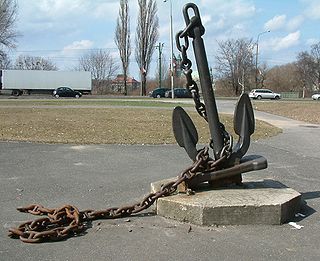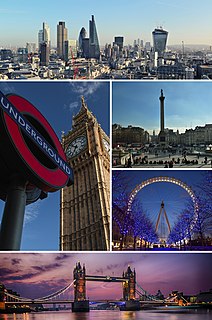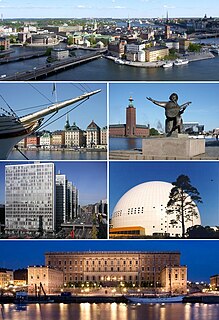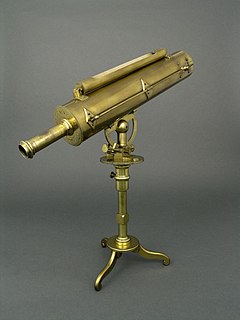

Mårten Triewald FRS (18 November 1691 – 8 August 1747), sometimes referred to as Mårten Triewald the Younger, was a Swedish merchant, engineer and amateur physicist. [1]

Fellowship of the Royal Society is an award granted to individuals that the Royal Society of London judges to have made a 'substantial contribution to the improvement of natural knowledge, including mathematics, engineering science and medical science'.

Engineers, as practitioners of engineering, are professionals who invent, design, analyze, build, and test machines, systems, structures and materials to fulfill objectives and requirements while considering the limitations imposed by practicality, regulation, safety, and cost. The word engineer is derived from the Latin words ingeniare and ingenium ("cleverness"). The foundational qualifications of an engineer typically include a four-year bachelor's degree in an engineering discipline, or in some jurisdictions, a master's degree in an engineering discipline plus four to six years of peer-reviewed professional practice and passage of engineering board examinations.

A physicist is a scientist who specializes in the field of physics, which encompasses the interactions of matter and energy at all length and time scales in the physical universe. Physicists generally are interested in the root or ultimate causes of phenomena, and usually frame their understanding in mathematical terms. Physicists work across a wide range of research fields, spanning all length scales: from sub-atomic and particle physics, through biological physics, to cosmological length scales encompassing the universe as a whole. The field generally includes two types of physicists: experimental physicists who specialize in the observation of physical phenomena and the analysis of experiments, and theoretical physicists who specialize in mathematical modeling of physical systems to rationalize, explain and predict natural phenomena. Physicists can apply their knowledge towards solving practical problems or to developing new technologies.
Mårten Triewald was the son of Mårten Triewald the Elder, a farrier and anchorsmith of German origin.

A farrier is a specialist in equine hoof care, including the trimming and balancing of horses' hooves and the placing of shoes on their hooves, if necessary. A farrier combines some blacksmith's skills with some veterinarian's skills to care for horses' feet.

An anchor is a device, normally made of metal, used to connect a vessel to the bed of a body of water to prevent the craft from drifting due to wind or current. The word derives from Latin ancora, which itself comes from the Greek ἄγκυρα (ankura).
Triewald's mercantile activities took him to London where he attended lectures in Newtonian Experimental Philosophy given by John Theophilus Desaguliers and with whom he later corresponded. In 1716 Triewald was employed as an inspector at a coal mine in Newcastle, where he studied mechanics and the steam engines used there, and made improvements to them. He returned to Sweden in 1726 and at Dannemora mine and built a steam engine there under the designation "fire and air machine" (eld- och luftmachin in archaic Swedish). This steam engine is believed to be the first steam engine in Sweden that was put to practical and industrial use.

London is the capital and largest city of both England and the United Kingdom. Standing on the River Thames in the south-east of England, at the head of its 50-mile (80 km) estuary leading to the North Sea, London has been a major settlement for two millennia. Londinium was founded by the Romans. The City of London, London's ancient core − an area of just 1.12 square miles (2.9 km2) and colloquially known as the Square Mile − retains boundaries that follow closely its medieval limits. The City of Westminster is also an Inner London borough holding city status. Greater London is governed by the Mayor of London and the London Assembly.

John Theophilus Desaguliers FRS was a French-born British natural philosopher, clergyman, engineer and freemason who was elected to the Royal Society in 1714 as experimental assistant to Isaac Newton. He had studied at Oxford and later popularized Newtonian theories and their practical applications in public lectures. Desaguliers's most important patron was James Brydges, 1st Duke of Chandos. As a Freemason, Desaguliers was instrumental in the success of the first Grand Lodge in London in the early 1720s and served as its third Grand Master.

Newcastle upon Tyne, commonly known as Newcastle, is a city in Tyne and Wear, North East England, 103 miles (166 km) south of Edinburgh and 277 miles (446 km) north of London on the northern bank of the River Tyne, 8.5 mi (13.7 km) from the North Sea. Newcastle is the most populous city in the North East, and forms the core of the Tyneside conurbation, the eighth most populous urban area in the United Kingdom. Newcastle is a member of the UK Core Cities Group and is a member of the Eurocities network of European cities.
In 1728 and 1729 Triewald held lectures in mechanics at the Swedish House of Nobility, and demonstrated a collection of physical instruments that he had bought in England. In 1732, these instruments were taken over by Lund University, and Triewald's assistant Daniel Menlös was made a professor of mathematics at the university. In 1729 he formed a diving company, and wrote about the use of diving bells and equipment for divers under the title Konsten att lefa under watn ("The art of living under water"). He also took an interest in bee-keeping and published on this subject (Tractat om bij, 1728).

Lund University is a public university, consistently ranked among the world's top 100 universities. The university, located in the city of Lund in the province of Scania, Sweden, arguably traces its roots back to 1425, when a Franciscan studium generale was founded in Lund next to the Lund Cathedral. After Sweden won Scania from Denmark in the 1658 Treaty of Roskilde, the university was founded in 1666 on the location of the old studium generale next to Lund Cathedral.

A diving bell is a rigid chamber used to transport divers from the surface to depth and back in open water, usually for the purpose of performing underwater work. The most common types are the open bottomed wet bell and the closed bell, which can maintain an internal pressure greater than the external ambient. Diving bells are usually suspended by a cable, and lifted and lowered by a winch from a surface support platform. Unlike a submersible, the diving bell is not designed to move under the control of its occupants, nor to operate independently of its launch and recovery system.
Triewald was given the title director mechanicus, and in 1735 was appointed kapten-mekanikus (Captain of Mechanics) at the Fortification Administration, deemed to be "the only one in the country suitable for this post", and given an annual pension by the Parliament.
In 1729, he was elected a member of the Royal Society of Sciences in Uppsala. In 1739, he was one of six founders of the Royal Swedish Academy of Sciences in Stockholm. He was also elected a Fellow of the Royal Society in 1731. [2]

The Royal Society of Sciences in Uppsala, is the oldest of the royal academies in Sweden. The society has, by royal decree of 1906, 50 Swedish fellows and 100 foreign.
The Royal Swedish Academy of Sciences is one of the royal academies of Sweden. Founded on June 2, 1739, it is an independent, non-governmental scientific organization which takes special responsibility for ptomoting the natural sciences and mathematics and strengthen their influence in society, whilst endeavouring to promote the exchange of ideas between various disciplines.

Stockholm is the capital of Sweden and the most populous urban area in the Nordic countries; 962,154 people live in the municipality, approximately 1.5 million in the urban area, and 2.3 million in the metropolitan area. The city stretches across fourteen islands where Lake Mälaren flows into the Baltic Sea. Just outside the city and along the coast is the island chain of the Stockholm archipelago. The area has been settled since the Stone Age, in the 6th millennium BC, and was founded as a city in 1252 by Swedish statesman Birger Jarl. It is also the capital of Stockholm County.
The mansion located in the southwestern part of Kungsholmen that Triewald bought in 1739, Triewalds malmgård, still exists and carries his name.

Kungsholmen is an island in Lake Mälaren in Sweden, part of central Stockholm. It is situated north of Riddarfjärden and considered part of the historical province Uppland. Its area is 3.9 km2 (1.5 sq mi) with a perimeter of 8.9 km (5.5 mi). The highest point is at Stadshagsplan at 47 metres (154 ft). The total population is 56,754.
Marten Triewalds daughter Margaret Elisabeth was married to accountant Johan Falkensson (died 1779) who leased Hersbyholm on Lidingö .
Mårten Triewald had a brother named Samuel von Triewald, poet, politician and one of the first 'critics' in Sweden; he was also a member of the Royal Swedish Academy of Sciences. [3]










